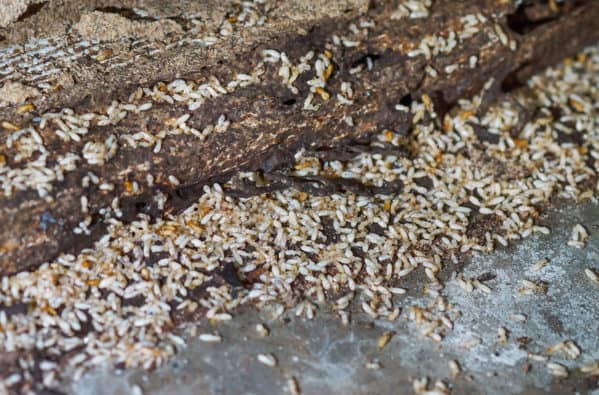READY TO GET STARTED?
REQUEST A FREE ESTIMATE
Fill out the form below or call (888) 466-7849 for a free, no-obligation estimate.

Termites cause billions of dollars in damage each year. Because they work from the inside out, infestations are often not found until significant damage has already been done. Spring marks the beginning of the termite swarming season and these destructive pests are found in most of the United States (except for Alaska). What do you need to know before swarming season starts to help control termites? Find out the answers to many of your termite questions below.
Termites swarm as the weather begins to warm, usually at the beginning of spring or summer and usually after a rain event. Termites swarm when they go in search of a location to establish a new colony. Colonies typically don’t produce a swarm until they have been established for at least 3 years.
If a swarm happens inside your home, most of them will not survive to establish a new colony but it does mean that your home is likely infested. If a swarm happens outside your home or if you notice just a few stragglers inside, your home is most likely not infested but a colony (or multiple colonies) are present nearby.
Swarming termites have one purpose – to reproduce and establish a new colony. In fact, they don’t have biting or chewing mouthparts to cause damage to your home. Several hundred swarmers are produced by each colony but only a small percentage of these actually survive to start the new colony.
Termites have straight antennae and wide bodies without pinched waists. They are usually black or dark brown in color. Swarming termites have wings that are the same length and clear in color. Termites are found in decaying stumps, trees, wood debris, lumber, and other wooden structures. They cause structural damage by eating wood and other cellulose-based products like paper.
Flying ants (also known as carpenter ants) have elbowed antennae and pinched waists. They can be black, brown or reddish in color. They have 2 pairs of wings that differ in size and are tinted brown in color. Carpenter ants also inhabit wood and wood structures; however, they don’t eat wood and therefore do not usually cause any structural damage. They do eat nectar, seeds, other insects, and food debris in and around your home.
Both termites and flying ants swarm as part of their mating process.
The main attractant to termites is food. Termites love to eat anything wood or cellulose-based including lumber, firewood, newspaper, and more. They also like warm, dark places that are undisturbed such as your crawlspace. They also thrive in moist soil, especially around your foundations.
While there are some do-it-yourself options you can do around your home, these are more suitable for termite prevention rather than termite control. Getting rid of termites is a job best left to the professionals. Some things you can do around your home to help prevent termites include:
There are two major types of termite treatment: liquids and baits.
Liquid termite treatments have been around for years. Their purpose is to provide a long-lasting barrier in the soil that keeps termites from entering and infesting buildings. This treatment also helps eliminate termites that are already inside structures as it prevents them from getting back to the soil for supplemental moisture.
Bait termite treatments use a cellulose-based food product combined with a slow acting pesticide. The bait stations are installed below the ground where termites eat the bait and share it with other termites in their colony. This leads to a gradual decline in the termite population infesting the structure.
If you suspect you have a termite problem, contact a professional termite control specialist. A thorough termite inspection by a trained pest control professional is critical in identifying and eliminating a termite infestation from your home.
Lawn Care: How to Keep Your Grass Green in the Summer
5 Ways To Prevent Bed Bugs When Traveling

With the weather thankfully getting more spring-like, it’s time for a good deep-clean of your home. While a good spring clean is great for your spirit, it will also aid in keeping pests out of the house, along with your quarterly pest service. That way, you get to enjoy a pest-free spring!
Ants, pantry pests, and other common spring pests will seek to invade your kitchen where they will find food and water with ease. A deep clean of your pantry and counters can greatly reduce the occurrence of pests. If it is feasible, clean out from behind your appliances; food will have fallen that pests will find. Also, place your trash can away from doors that lead in from outside and away from windows.
Roaches and silverfish tend to be attracted to bathrooms due to the excess moisture. Reducing sources of water is the best solution to ward off an infestation. Check around tubs, sinks, and toilets for any leaks, and wipe off standing water on any surfaces.
The perfect hiding place for pests is often your basement. Mice, spiders, and many others like the dark corners to hide from the outside. Instead of using cardboard boxes for storage, go for plastic tubs with secure lids. Also, make sure to seal any found cracks; mice only need ¼” opening to enter your home!
A spring clean of the exterior of your home is crucial. Start with moving any plants and vegetation away from your home to make it harder for pests to come in. Be sure to clean out clogged gutters to eliminate another pest hiding place. You may want to consider installing gutter guards to avoid the possibility of clogged gutters. Other tips to remember: dispose of leaf piles properly and keep grass cut low.
If you suspect a pest problem in your home, contact a pest control company. They will be able to evaluate your home, identify what kind of pest you are having issues with, and set you up with a comprehensive treatment plan.